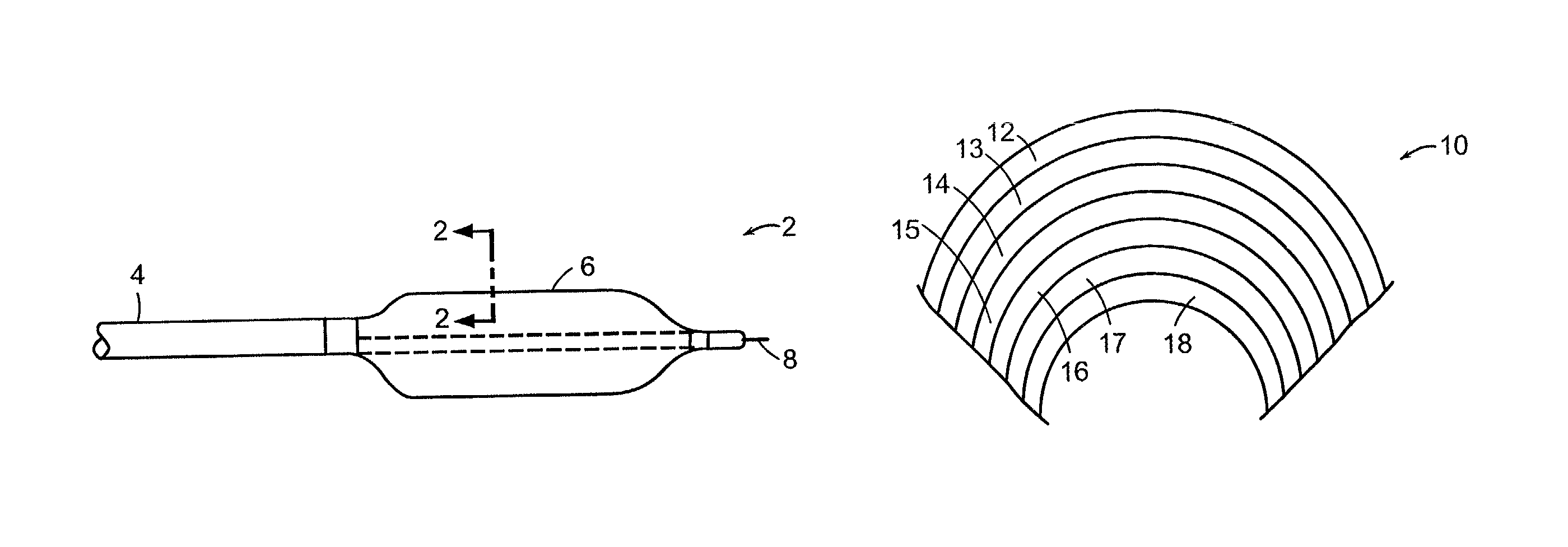Multilayer medical device
a medical device and multi-layer technology, applied in the field of multi-layer medical devices, can solve problems such as mechanical failure, achieve the effects of improving burst strength, and reducing burst pressure and/or puncture resistan
- Summary
- Abstract
- Description
- Claims
- Application Information
AI Technical Summary
Benefits of technology
Problems solved by technology
Method used
Image
Examples
example 1
[0098]A thirteen layer tubing was formed by coextruding Pebax 7033 and mixture of Pebax 5533 (85% by weight) and Pebax 2533 (15% by weight) in an alternate layer structure. A soft layer of Pebax 5533 / Pebax 2533 mixture was the outermost layer. The material (by thickness) ratio of Pebax 7033 to the mixture was about 4 to 1. Four 3.25 mm balloons were made from tubing of 0.0170 ID×0.0342 OD (inch). The balloons were formed at 95° C. and 515 psi forming pressure. The balloons had a double wall thickness of 0.00150 inch. The soft polymer layers were about 0.54 micron thick. The hard polymer layers were about 2.54 micron thick. The balloon burst at about 309 psi and calculated burst strength was about 26,250 psi.
example 2
[0099]A seven layer tubing was coextruded with Pebax 7033 and Pebax 5533 in an alternate layer structure. A soft layer of Pebax 5533 was the outermost layer. The material ratio (by thickness) of Pebax 7033 to Pebax 5533 was about 4 to 1. Four 3.0 mm balloons were made from tubing of 0.0200 ID×0.0330 OD (inch). The balloons were formed at 95° C. and at 360 psi forming pressure. The balloons had a double wall thickness of 0.00140 inch. The soft layers were about 1μ thick and the hard layers were about 4μ thick. The balloons burst at about 286 psi and had a calculated burst strength about 26,000 psi.
example 3
[0100]A thirteen layer tubing was formed by coextruding Pebax 7033 and Pebax 5533 in an alternate layer structure. A soft layer of Pebax 5533 was the outermost layer. The material (by thickness) ratio of Pebax 7033 to Pebax 5533 was about 4 to 1. Five 3.0 mm balloons were made from tubing of0.0184 ID×0.0348 OD (inch). The balloons were formed at 95° C. and 400 psi forming pressure. The balloons had a double wall thickness of 0.00140 inch. The soft polymer layers were about 0.5μ thick. The hard polymer layers were about 2.3μ thick. The balloon bursts at about 288 psi and calculated burst strength was about 26,000 psi.
PUM
| Property | Measurement | Unit |
|---|---|---|
| thickness | aaaaa | aaaaa |
| thickness | aaaaa | aaaaa |
| thickness | aaaaa | aaaaa |
Abstract
Description
Claims
Application Information
 Login to View More
Login to View More - R&D
- Intellectual Property
- Life Sciences
- Materials
- Tech Scout
- Unparalleled Data Quality
- Higher Quality Content
- 60% Fewer Hallucinations
Browse by: Latest US Patents, China's latest patents, Technical Efficacy Thesaurus, Application Domain, Technology Topic, Popular Technical Reports.
© 2025 PatSnap. All rights reserved.Legal|Privacy policy|Modern Slavery Act Transparency Statement|Sitemap|About US| Contact US: help@patsnap.com



